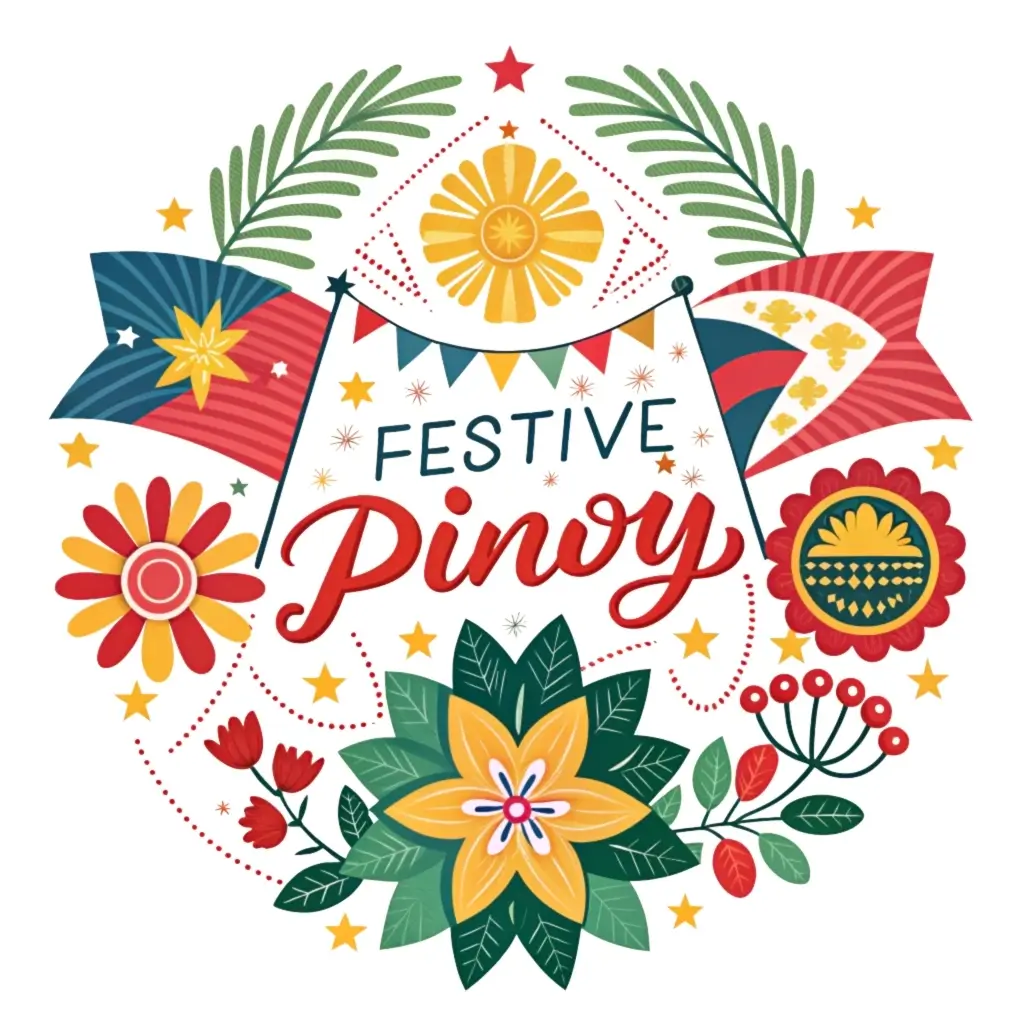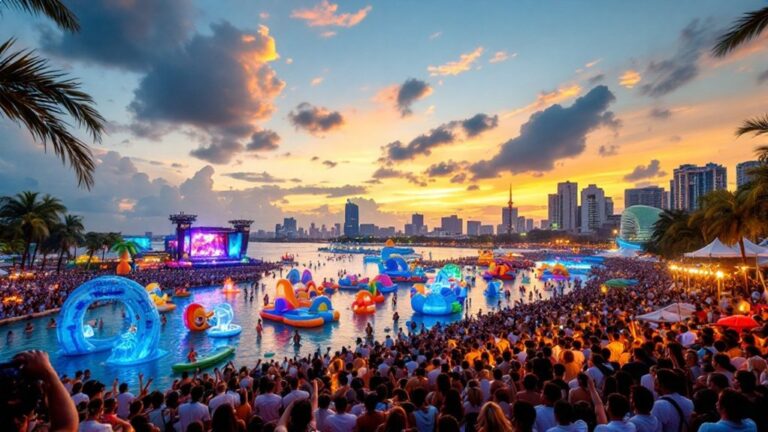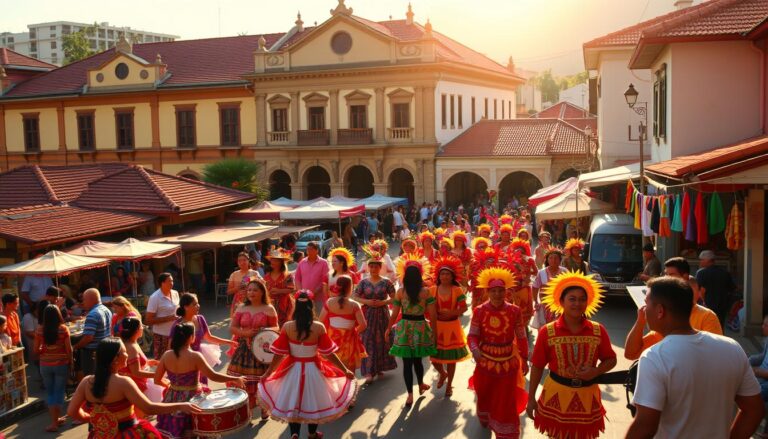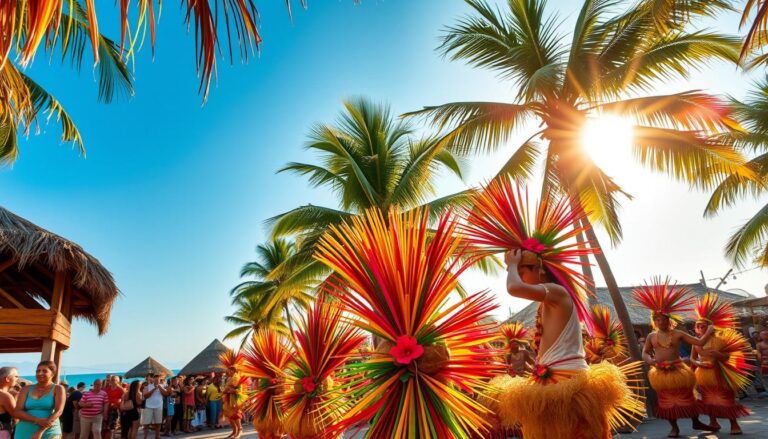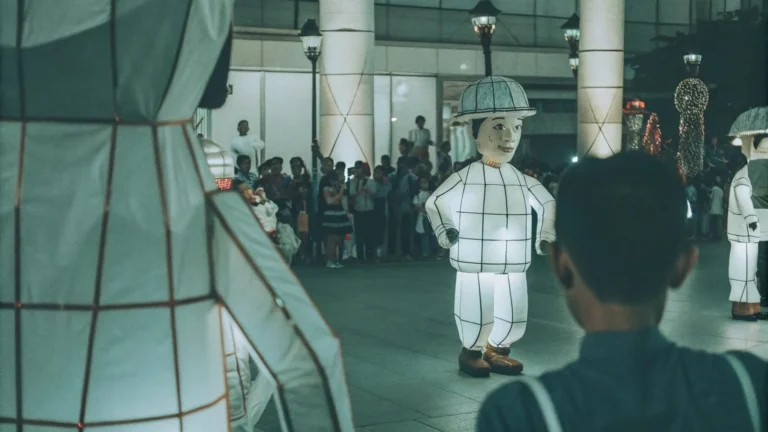Kaamulan Festival Philippines
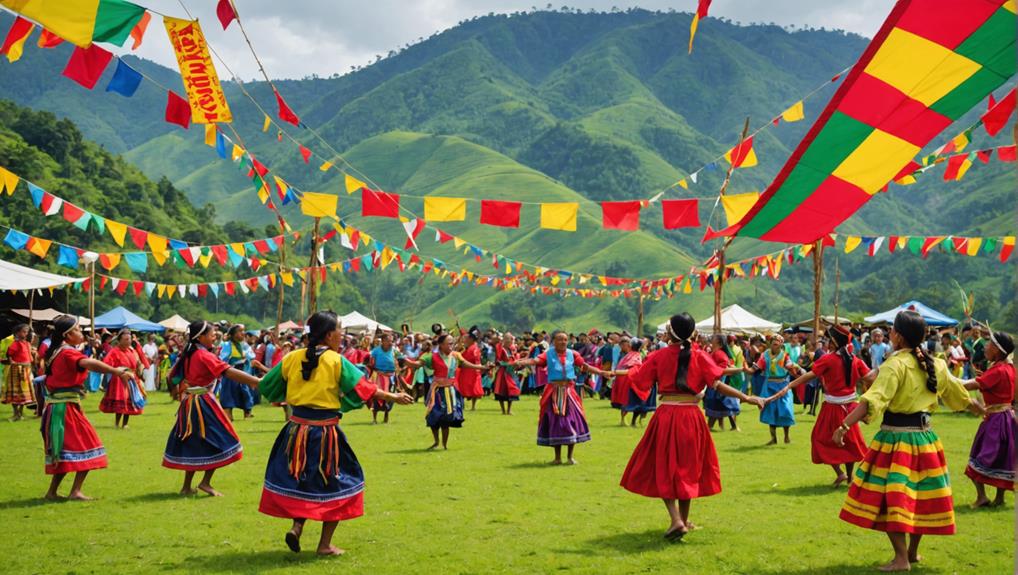
You can immerse yourself in the rich cultural heritage of the Philippines at the Kaamulan Festival in Bukidnon. This unique event celebrates the customs and traditions of the seven indigenous tribes in the region through vibrant street dances, colourful folk costumes, and traditional rituals.
Running annually from late February to mid-April in Malaybalay, it’s the perfect time to enjoy the cooler weather while exploring authentic tribal music, dance, and crafts. Engaging with the festivities not only respects local traditions but also enhances your understanding of the area’s history and people. Curiosity may just lead you to uncover deeper insights into this lively celebration.
Key Takeaways
- The Kaamulan Festival is an annual event in Malaybalay, Bukidnon, celebrating the culture of 7 indigenous tribes.
- It features traditional rituals, dances, and crafts highlighting tribal heritage.
- The festival runs from late February to mid-April, ideal for cooler weather activities.
- Activities include indigenous performances, street dancing, and an agro-industrial fair.
- The festival promotes cultural respect; visitors are encouraged to wear traditional attire appropriately.
Kaamulan Festival Philippines At A Glance
| Facts | Brief Explanation |
|---|---|
| Name of the Festival | Kaamulan Festival |
| Type of Festival | Cultural and Agricultural |
| City of Origin | Malaybalay City, Bukidnon |
| Festival Etymology | “Kaamulan” comes from the Binukid word “amul,” meaning “to gather” |
| Date First Celebrated | 1974 |
| Annual Celebration Dates | March to April (usually lasts for two weeks) |
| Founder of the Festival | Governor Carlos O. Fortich |
| Brief History of the Festival | The Kaamulan Festival was established to celebrate the culture and traditions of Bukidnon’s seven indigenous tribes: Bukidnon, Higaonon, Talaandig, Manobo, Matigsalug, Tigwahanon, and Umayamnon. It showcases their rituals, dances, and crafts, promoting cultural preservation and unity among the tribes. |
| Brief History of Malaybalay City | Malaybalay, formerly called Oroquieta del Interior, was established as a pueblo in 1877. It became a chartered city in 1998. The city has a rich history of indigenous culture and Spanish colonial influence, serving as an important administrative center in Bukidnon province. |
| Ethnic Information | Malaybalay is home to various indigenous groups, primarily the seven tribes of Bukidnon. The city also has a significant population of migrants from other parts of the Philippines. |
| Location in the Country | Malaybalay City is located in the north-central part of Mindanao, the second-largest island in the Philippines. It is the capital city of Bukidnon province. |
| How to Reach the City | • By air: Fly to Laguindingan Airport in Cagayan de Oro, then take a 2-3 hour bus or van ride to Malaybalay • By land: Take a bus from major cities like Davao or Cagayan de Oro |
| Nearby Cities/Towns | • Valencia City (26 km) • Maramag (48 km) • Quezon (61 km) • Don Carlos (70 km) • Kadingilan (80 km) |
| Google Map Link | Malaybalay City on Google Maps |
| Main Events and Activities | • Street dancing competition • Indigenous games • Tribal rituals and ceremonies • Agricultural trade fairs • Cultural exhibits • Beauty pageant (Piniliyap ha Bukidnon) |
| Famous Tourist Attractions | • Kaamulan Grounds: Main venue for festival events • Bukidnon Provincial Capitol: Seat of the provincial government with impressive architecture • Monastery of Transfiguration: Cone-shaped church designed by National Artist Leandro Locsin • Mt. Capistrano: Sacred mountain with unique rock formations • Nasuli Spring: Natural cold spring with cultural significance to local tribes |
| Famous Food Dishes | • Binaki (steamed corn cakes) • Palagsing (sago palm and coconut delicacy) • Kinilaw na Talong (eggplant ceviche) • Pinya Ham (pineapple ham) |
| Related Festivals | • Naliyagan Festival (Agusan del Sur) • Kalilangan Festival (General Santos City) • Kadayawan Festival (Davao City) |
Festival Overview
Each year, the Kaamulan Festival in Bukidnon, Philippines, brings to life the rich cultural tapestry of the region’s seven Indigenous hill tribes through colourful rituals, music, dances, and crafts. You’ll be swept away by the vibrant atmosphere, where each element showcases the depth of tradition that the Talaandig, Higaonon, Bukidnon, Manobo, Matigsalug, Tigwahanon, and Umayamnon communities preserve and celebrate.
As you immerse yourself in the festival, you’ll witness a series of traditional rituals that aren’t just ceremonies but are profound expressions of cultural beliefs and practices. These rituals, deeply embedded in the spiritual life of the tribes, often commence with offerings to the spirits of their ancestors, ensuring peace and prosperity.
The tribal dances are a festival highlight, each step and movement rich with historical and symbolic meaning. You’ll see dancers adorned in elaborate costumes, their movements telling stories of harvest, war, and community life. These dances aren’t just performed; they’re lived, with every beat of the drum resonating through the crowd.
Indigenous crafts also play a significant role at Kaamulan. You’ll have the chance to explore various booths displaying intricate beadwork, weaving, and woodcarving, each piece a reflection of the tribes’ artistic skills and deep connection to their environment.
The cultural significance of Kaamulan isn’t just in its preservation of traditions; it’s a vibrant, ongoing celebration of identity and heritage. These colourful celebrations serve as a bridge between generations, teaching young tribe members and visitors alike about the rich history and vibrant presence of these Indigenous communities.
Historical Origins
Kaamulan began on May 15, 1974, during the town fiesta of Malaybalay. Vice Mayor Edilberto Mamawag invited indigenous people to perform dances, which became popular, leading to the festival’s formal adoption as Northern Mindanao’s regional festival by the Regional Development Council on September 16, 1977.
Initially held in the first week of September, the festival was moved to February-March in 1999 to align with Bukidnon’s foundation celebration. The Kaamulan Festival has the potential to be included in UNESCO’s Intangible Cultural Heritage List.
Here’s a snapshot of how these elements are intertwined in the festival:
| Aspect | Details | Impact on Festival |
|---|---|---|
| Pre-colonial Roots | Origin from tribal rituals | Foundation for events and themes |
| Indigenous Celebrations | Showcases tribal music, dance | Enhances cultural engagement |
| Cultural Preservation | Revives ancient customs | Educates and entertains the audience |
| Unity through Diversity | Integration of 7 tribes | Promotes social cohesion |
| Heritage Promotion | Highlights regional history | Attracts tourism and awareness |
Location and Schedule
Set against the scenic backdrop of Bukidnon, Mindanao, the Kaamulan Festival unfolds annually from late February to mid-April, primarily hosted in Malaybalay, the provincial capital. You’ll find yourself immersed in a rich cultural tapestry, where event logistics are meticulously planned to enhance your experience. The festival’s timing, during the cooler, drier months, makes it ideal for the outdoor activities that fill the schedule. As you wander through the bustling streets, be sure to catch the traditional dances, music performances, and colorful parades that showcase the diverse indigenous tribes of Bukidnon. The Kaamulan Festival holds a special place in the region’s history and significance, as it not only celebrates the rich heritage and traditions of the indigenous peoples but also serves as a platform for fostering unity and understanding among the different cultural groups. Much like the Sinulog Festival’s history and significance in Cebu, the Kaamulan Festival is a time for the community to come together and honor their roots.
Navigating the festival is part of the adventure. Malaybalay is accessible by road from major cities in Mindanao, and once you’re there, local transport options can whisk you to various event locations. Accommodations range from hotels to local homestays, offering you a genuine slice of life in Bukidnon. This is where you’ll engage with the locals, whose warmth and hospitality are as integral to the Kaamulan experience as the events themselves.
The festive atmosphere is palpable, with streets decked out in vibrant hues and the sounds of Indigenous music filling the air. This regional experience isn’t just about watching; it’s about participating. Whether you’re trying your hand at traditional crafts, joining a dance, or simply conversing with the tribespeople, every moment at Kaamulan deepens your understanding of the culture.
Your cultural immersion during the Kaamulan Festival is both a journey through and a celebration of the indigenous heritage of the region. It’s a unique opportunity to witness and engage in traditions that have been passed down through generations, ensuring a profoundly personal connection to the heart of Mindanao.
Activities and Highlights
You’ll explore the Kaamulan Festival’s essence through its array of activities and highlights, each designed to celebrate and preserve the rich indigenous culture. As you meander through the bustling streets of Malaybalay, you’ll be captivated by the vibrant indigenous performances.
- One of the standout features is the street dancing. It’s not just a dance; it’s a storytelling medium where colourful costumes and rhythmic movements bring folklore to life right before your eyes. You’re not just watching a dance; you’re experiencing a centuries-old narrative unfold through each step and beat.
- Don’t miss the traditional rituals, a series of solemn and sacred ceremonies that offer a glimpse into the spiritual life of the indigenous communities. These rituals are a bridge to the past, connecting the modern festivities with the ancient customs and beliefs of the tribal ancestors.
- For a closer look into tribal culture, visit the cultural exhibits. Here, you’ll find a range of artifacts, handicrafts, and multimedia presentations that showcase the rich tapestry of local history and artistry.
- Lastly, the Agro-industrial fair presents an opportunity to appreciate the region’s agricultural prowess. You can explore booths featuring local produce and crafts, providing insights into the economic activities that sustain the tribal communities.
| Activity Type | Description | Location |
|---|---|---|
| Indigenous Performances | Traditional music and dance | Various Venues |
| Street Dancing | Competitive tribal dance showcase | Main Streets |
| Traditional Rituals | Sacred ceremonies and rituals | Tribal Areas |
| Cultural Exhibits | Displays of artifacts and crafts | Exhibit Halls |
| Agro-Industrial Fair | Local produce and crafts fair | Fair Grounds |
Etiquette and Tips

After exploring the vibrant activities at the Kaamulan Festival, it’s important to know how to participate respectfully and make the most of your visit.
- First off, let’s talk about cultural attire. When you’re packing, remember that wearing traditional outfits shows respect and appreciation for local culture. However, it’s vital to make sure you’re adopting these styles in a way that’s sensitive and informed. Research or ask for guidance on appropriate wear to avoid cultural appropriation.
- Next, consider some travel suggestions to enhance your experience. Plan your trip well in advance, especially since accommodations in Malaybalay can fill up quickly during the festival period. It’s also wise to learn a few phrases in Binukid or Cebuano to connect more deeply with the locals.
- Engaging with the festival respectfully is key. Always ask permission before taking photos of participants or sacred rituals. This respectful engagement not only shows your reverence for the culture but also enriches your interaction with the community.
- Waste management is another critical aspect. The festival thrives on its pristine, natural settings, so do your part by using reusable containers and properly disposing of any trash. Many areas will have designated recycling bins.
- Lastly, embrace the local hospitality. Bukidnon locals are known for their warmth and generosity. Accepting their kindness and participating in community activities can provide a more authentic and memorable experience.
Interesting Facts About Kaamulan Festival
- 🏞️ Kaamulan Festival is celebrated in Bukidnon, a landlocked province in Northern Mindanao, Philippines.
- 🗓️ Unlike many festivals that occur on fixed dates, Kaamulan is typically celebrated for several months, usually from February to March.
- 👥 The festival brings together seven ethnic tribal groups of Bukidnon: the Bukidnon, Higaonon, Talaandig, Manobo, Matigsalug, Tigwahanon, and Umayamnon.
- 🌱 “Kaamulan” comes from the Binukid word “amul,” meaning “to gather” or “to assemble.”
- 🎭 The festival features various indigenous rituals, including the “Pamuhát” or thanksgiving ritual.
- 🏹 Traditional games like “Panagsabong” (cockfighting) and “Pana” (archery) are often showcased during the festival.
- 👗 Each tribal group displays their unique traditional costumes, often adorned with intricate beadwork and vibrant colours.
- 🎶 The “Kaamulan Ethnic Street Dancing Competition” is a major highlight, featuring dancers performing indigenous music.
- 🍲 Local delicacies like “Binaki” (steamed corn cakes) and “Nilupak” (mashed cassava with coconut) are popular during the festival.
- 🏆 In 2018, Kaamulan Festival set a Guinness World Record for the largest gathering of ethnic tribes in the Philippines.
Frequently Asked Questions
How Does Kaamulan Festival Impact Local Bukidnon Economy?
You’ll see the local economy thrive as tourist spending increases, vendor opportunities expand, and employment gets a boost. The festival also promotes culture and spikes demand for accommodations, greatly benefiting the community.
Are There Specific Rituals That Open and Close the Festival?
Yes, specific rituals open and close the festival. Opening ceremonies often feature ancestral practices and spiritual elements, highlighting ritual significance. Closing traditions similarly reflect deep cultural roots, marking the festival’s end with significance.
What Languages Are Predominantly Spoken During Kaamulan?
At the festival, you’ll mostly hear ethnic dialects and Binukid, emphasizing cultural linguistics and language preservation. Festival communication thrives on multilingual interactions, enriching your experience with diverse linguistic expressions.
How Do Local Schools Participate in the Festival?
You’ll see local schools actively engaging through student performances, artistic exhibitions, and cultural workshops. They also participate in parades, demonstrating educational involvement that enriches both the festival’s spirit and student experience.
What Are the Transportation Options to Malaybalay for Kaamulan?
You’ve got several options to reach Malaybalay: bus routes cover the area well, car rentals and motorcycle hire are available, or you could fly in and use local drivers for convenience.
Conclusion
The Kaamulan Festival stands as a vibrant celebration of Bukidnon’s rich cultural heritage, uniting the province’s seven ethnic tribes in a colourful display of tradition and unity. This annual event not only preserves indigenous customs but also promotes cultural understanding and tourism in the region.
As the festival continues to grow, it remains an essential platform for showcasing the unique identity of Bukidnon’s people and their enduring connection to their ancestral lands.
